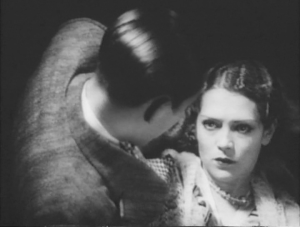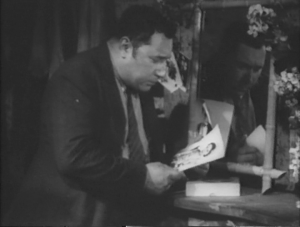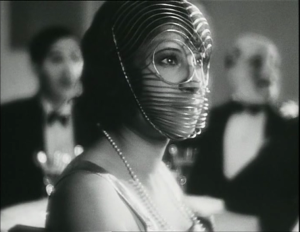 Review: One Night Only
Review: One Night Only
La petite Lise | Jean Grémillon | France | 1930 | 85 min
Daïnah la métisse | Jean Grémillon | France | 1932 | 48 min
UW Cinematheque, Saturday, September 19, 7:00pm»
This week LakeFrontRow and the Madison Film Forum preview the Jean Grémillon series at the UW Cinematheque, which begins on Saturday, September 12. At LakeFrontRow, Grant Phipps examines Remorques (1941).
Below, James Kreul looks at two early sound films by Grémillon, La petite Lise (1930) and Daïnah la métisse (1932), presented as a double feature in the series. Both are relatively conventional melodramas from famed screenwriter Charles Spaak, but each one has bursts of visual energy that reflect Grémillon’s ciné-club roots.
Like many, I come to the Jean Grémillon series at the UW Cinematheque this Fall somewhat in the dark. Grémillon’s work is on that list of films that I “know about” but haven’t until now had the opportunity to see. As Jonah Horwitz points out on the Cinematheque blog, many of his films are appreciated in the context of poetic realism and the star persona of Jean Gabin rather than strictly as “Grémillon films.” The two films I’ll examine here could similarly be discussed in the context of screenwriter Charles Spaak’s career, rather than as examples of Grémillon authorship. But rather than tease out Grémillon’s status as an auteur, here I’ll discuss La Petite Lise (1930) and Daïnah la métisse (1932) in relation to the scenes that jumped out at me and had a life of their own.
While narratively both films could be viewed as relatively conventional melodramas (with intriguing social and political dimensions), both films also feature some knockout scenes that reflect two distinct ideas within film history and culture: “cinema as a window,” and “cinema as a canvas.” When Grémillon steps away from the narrative in these films and explores these ideas, the results are quite exhilarating.
Cinema as a Window: La petite Lise
It did not surprise me to learn from Horwitz’s notes that the Grémillon began his cinematic career as a ciné-club host. European ciné-clubs endeavored to bring a wide range of cinema, from Hollywood commercial features to the European and Soviet avant-garde (usually an emphasis on the latter), to local screens. These ciné-clubs were also interested in the flow of ideas about cinema. If we define modernism broadly as the move by artists to discover the essential properties of their medium, then modernist filmmakers (and theorists) began to answer that question in two ways (I’m simplifying things, of course).
Some filmmakers in the tradition of the Lumière brothers focused on the cinema’s ability to reproduce the phenomenal reality in front of the camera; these filmmakers gravitated towards realism in narrative filmmaking and, of course, documentary filmmaking. Other filmmakers in the tradition of Georges Méliès focused on the cinema’s ability to transform reality by crafting and manipulating the image. Eisenstein’s developed this line of thought through his evolving concept of montage, as did several filmmakers associated with French Impressionism (and the European avant-garde, in general). By organizing ciné-club events, Grémillon would have encountered these ideas and likely participated in debates about the very definition of cinema.
Le petite Lise is usually discussed as an early example of poetic realism, so it shouldn’t surprise you that I will discuss two scenes in the Lumière tradition. In their Film History, Thompson and Bordwell explain that poetic realism films “often center on characters living on the margins of society, either as unemployed members of the working class or as criminals…the overall tone is one of nostalgia and bitterness.” But what interests me about these scenes in Le petite Lise is not their reflection social realities that weren’t usually seen in mainstream Hollywood fare, but rather their attempt to vibrantly capture seemingly unstaged reality in front of the camera.
 Le petite Lise centers on Victor Berthier (Pierre Alcover), a convict who suddenly has an opportunity to return as a free man to his daughter Lise (Nadia Sibirskaïa) in Paris. Victor had killed Lise’s mother in a crime of passion, and he now wants to repair his relationship with his daughter. Unfortunately during his 10-year absence, Lise has resorted to a life of prostitution. Lise and her pimp, André (Julien Bertheau) have a scheme to get enough money to escape their current lifestyle. When Victor arrives in Paris, he begins to piece his life back together and finds work. But he has no idea about the life his daughter is leading, or the danger she is about to get herself into. Plot wise, once these pieces are set in play, it is not hard to predict where things will go or how things will turn out, particularly if you know your poetic realism. Alcover’s imposing presence as Victor combines nostalgia and melancholy to keep the audience emotionally involved as the plot machinations connect the melodramatic dots.
Le petite Lise centers on Victor Berthier (Pierre Alcover), a convict who suddenly has an opportunity to return as a free man to his daughter Lise (Nadia Sibirskaïa) in Paris. Victor had killed Lise’s mother in a crime of passion, and he now wants to repair his relationship with his daughter. Unfortunately during his 10-year absence, Lise has resorted to a life of prostitution. Lise and her pimp, André (Julien Bertheau) have a scheme to get enough money to escape their current lifestyle. When Victor arrives in Paris, he begins to piece his life back together and finds work. But he has no idea about the life his daughter is leading, or the danger she is about to get herself into. Plot wise, once these pieces are set in play, it is not hard to predict where things will go or how things will turn out, particularly if you know your poetic realism. Alcover’s imposing presence as Victor combines nostalgia and melancholy to keep the audience emotionally involved as the plot machinations connect the melodramatic dots.
Two scenes on the periphery of the central plot really stand out in terms of film style, however. And regardless of whether Grémillon explicitly staged the action, they both attempt to achieve the feeling of unstaged reality in front of the camera. The first is in the Cayenne prison just after Victor discovers that the warden has secured an early release for him. As Victor returns to the barracks, we see hardened, tattooed men surviving within graffiti tagged walls not unlike what we might imagine in a Genet novel (or what we seen in stylized form in Genet’s film, Un Chant d’Amour).
After a smooth tracking shot down the aisle, the camera haphazardly examines the tagged walls before returning to the men in the foreground. After the guard briefly looks in through the peep hole, the men begin to do as they please. The energy in the scene explodes as the camera and editing attempt to keep up with the men and their movements. Smoke fills the room and the men weave in and out of the frame. I’m not always sure exactly what is going on in a given shot, but instead of being confusing it is liberating. After being pinned down in conventionally shot scenes, here is a sequence bursting with life beyond the frame.
The second sequence comes late in the film, as Victor searches for Lise at a small local cabaret. Once again, what makes this sequence jump out is its commitment to stepping back and letting the action in front of the camera do all the work. As soon as the music takes over, you want to watch every single small movement of the cabaret performer as he mesmerizes the audience. Wow. I could watch this guy forever. And the energy in the room reminds me of the opening credits of Cassavetes’s Shadows (1959), as Ben (Ben Carruthers) works his way though a crowded house party.
Again, I’m not particularly interested in the degree to which these sequences were staged by Grémillon. My point is that they both explore the idea of capturing unstaged reality in front of the camera, an idea that was explored in new ways by subsequent narrative and documentary filmmakers as new technologies allowed new techniques. Both sequences convey the “fly on the wall” feeling that cinema verite and direct cinema documentary filmmakers would eventually fine tune with access to portable sound equipment. And both sequences anticipate the kind of cinema championed by André Bazin, including the movements that came after him like the French New Wave (Truffaut, Godard, etc.) and the New American Cinema (Cassavetes, Mekas, Warhol, Clarke).
While Alcover’s performance is impressive enough to carry most of La petite Lise, most of the film is relatively static. When these scenes appear, however, the screen comes to life in a way that must have made the ciné-club crowd, including Grémillon, excited about the possibilities of cinema.
Cinema as a Canvas: Daïnah la métisse
Europeans have always been better than American filmmakers in understanding the subversive potential of melodrama (and most American filmmakers who do understand this learned their lessons from Douglas Sirk’s Hollywood films). With Daïnah la métisse, we have potentially explosive social tensions that melodrama can exploit more explicitly than many other forms. Daïnah (Laurence Clavius) is the mixed-race wife of a black man (“Le mari” in the credits, Habib Benglia) who has been hired to perform magic on a cruise ship bound for New Caledonia. Daïnah has a large degree of freedom for a married woman for reasons never clearly explained, and she openly flirts with all the male passengers and crew. Things get complicated when she turns down the advances of an engine mechanic (Charles Vanel) and bites him to escape. Grémillon and Spaak explore race and class issues that are in some ways ahead of their time, and in some ways very much of their time. I’ll leave it up to the viewer to decide to what degree they’re critiquing the ideology of “exoticism” or to what degree they’re subscribing to it.
 As Cahiers du Cinéma correspondent Nicholas Elliot put it, in Daïnah “the issues are as in your face and complicated as they are now, but relayed in purely visual, cinematic terms that leave the viewer to sort through the discomfort alone.” Elliot attempted but failed to find a politically correct translation of the French métisse, a term for a person of mixed black and white parentage (the subtitles I had translated it as the generally offensive “mulatto”). He also suggests that producing studio Gaumont was uncomfortable enough with the subject matter that they trimmed the film down to its current 40-minute length. In my opinion, the film is most interesting when the race and class issues are incredibly messy; when the film turns into a relatively standard mystery and revenge plot, both the social dynamic and the visual style become somewhat stagnant.
As Cahiers du Cinéma correspondent Nicholas Elliot put it, in Daïnah “the issues are as in your face and complicated as they are now, but relayed in purely visual, cinematic terms that leave the viewer to sort through the discomfort alone.” Elliot attempted but failed to find a politically correct translation of the French métisse, a term for a person of mixed black and white parentage (the subtitles I had translated it as the generally offensive “mulatto”). He also suggests that producing studio Gaumont was uncomfortable enough with the subject matter that they trimmed the film down to its current 40-minute length. In my opinion, the film is most interesting when the race and class issues are incredibly messy; when the film turns into a relatively standard mystery and revenge plot, both the social dynamic and the visual style become somewhat stagnant.
But to return to my central idea, there is one scene in Daïnah that truly leaps off the screen, and explores the “cinema as a canvas.” Daïnah’s husband performs at what appears to be a masked ball, and Grémillon uses all of the tricks of the trade to manipulate the mise-en-scene and the photographic image to create what almost seems like an Impressionist short within the larger narrative.
I don’t pretend to understand what’s literally happening on stage, but visually it is fantastic. Narratively all we need is some kind of magic act, but Grémillon goes well beyond that to create a kind phantasmagoria of light and shadow. Beyond the basic manipulation of light in the mise-en-scene, we see some relatively crude special effects with the appearance of the bird. The abstract quality of the bird’s appearance and its subsequent disappearance through editing gives the sequence a distinct charm. Grémillon both looks back to previous experimental shorts (the small crystal ball recalls simple image manipulations in Leger’s Ballet Mécanique) and anticipates future ones (Daïnah’s mask reminds one of Anais Nin’s appearance in Kenneth Anger’s Inauguration of the Pleasure Dome). This is the opposite of the “fly on the wall” tradition; here Grémillon wants to manipulate every inch and every aspect of his canvas.
It’s hard to believe that the cabaret scene in La petite Lise and the magic act in Daïnah la métisse come from the same filmmaker, unless you believe that Grémillon was exposed to and interested in a wide range of ideas about the cinema. Perhaps this is another reason, as Horwitz suggests, it is rather difficult to classify Grémillon and his work in the larger context of French cinema. Since these are the only Grémillon films I’ve seen, I look forward to exploring his other films in the Cinematheque series with the hope that I will discover additional liberating and exhilarating moments of visual pleasure.